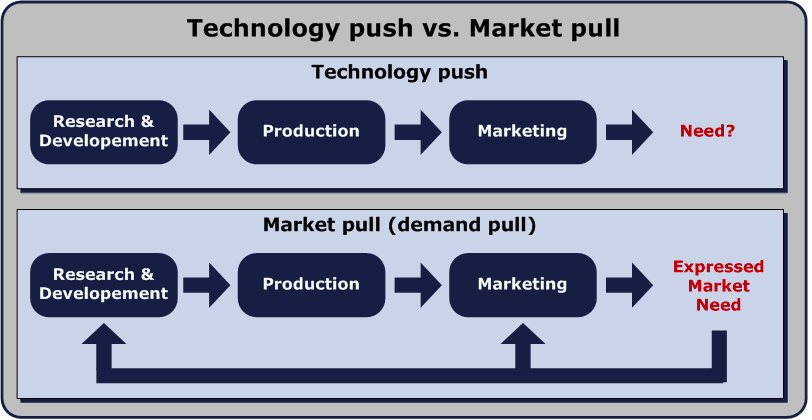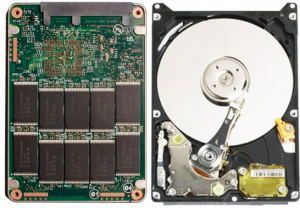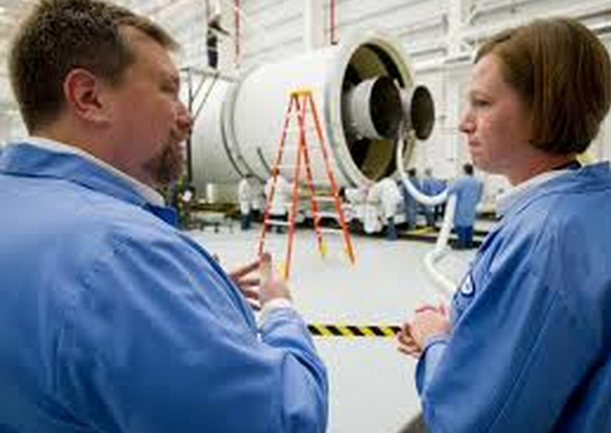Pushing technologies onto the market is often derided by innovators. They are countless technologies that have never found a market and that turned out to be failed innovations. But, the fact is that there’s :
- The wrong way of pushing technologies on the market
- The right way of pushing technologies on the market
This is the subject I want to address in this post.
I/ The difference between market pull and technology push

II/ Launching novel technologies onto the market
Large technology-driven companies have a natural tendency to push a given technology offering onto the marketplace. This is often referred to as « technology push ». Inventors, engineers, R&D managers spend a lot of their time developing novel technologies. Once they have tested their technology, once they know their technologies work, then, the next step is to launch their technologies onto the market.
At that point, the question becomes: given what my technology can do, what are the market segments that would be interested in its functionalities ?
Most of the time, General Managers, under intense pressure from their shareholders, have a tendency to incorporate this new technology into an existing product portfolio. This should create additional value to their customers.
III/ But what happens when the novel technology isn’t performance-competitive relative to existing technologies ?
General Managers are logically reluctant to incorporate these new technologies into their existing product offerings. They choose to continue to invest in improving the technology so that it becomes performance-competitive relative to existing technologies before they incorporate them into existing products. And this means more investments and delayed Return On Investments (R.O.I).

A better way to secure R.O.I faster would be to accept the technology as it is and find a market for it. This is a classic example of the Solid-State Drive (SSD). For example, when SSD hard drives came out they had much lower memory capacity than existing disk drives. But, they offered other advantages, including the fact that they were much more robust and sturdy, simply because, unlike existing hardrives, they had no moving parts.
Therefore, the real challenge in pushing the SSD technology onto the market is not so much whether the SSD technology should be included into existing computers. If SSD disks had been incorporated into existing computers, they would have offered such a low memory capacity, that SSD computers would have been uncompetitive on the market place.
IV/ How to succeed at technology push innovation ?Accepting the novel technology as it is
So the question is not : how do I incorporate a novel technology that’s not performance-competitive into my product offering ? The real question is : what markets could be interested in having robust and sturdy hard drives that have low memory capacity ? In other words, what markets would be interested in the technology as it is ? What markets would be interested in the technology despite its limitations ?
The answer ?

The mobile phone market. Mobile phones are always carried around and they need to be sturdy. However, the need for memory capacity on mobile phones is lower than it is for computers. The mobile phone market turned out to be a very good market for SSD hard drives.
To sum up :
- The wrong way of pushing novel technologies on the market involves wanting to improve its performance in order to include it in an existing product offering
- The right way of pushing novel technologies on the market involves accepting the novel technologies as it is despite its limitations
Further Readings :
- For another analysis of technology push, please refer to Clayton Christensen’s Innovator’s Dilemma, chapter 11
- For another definition of technology push, please refer here and here on BBC website
- For a discussion on the risks inherent to technology push innovation and several examples from Sony, please refer here
- For a discussion on why large companies fail to innovate, please refer here
- For a discussion on the unique Pygmalion-like love story between an inventor and his invention, please refer here

[…] une description de comment réussir l’innovation techno-push, veuillez-vous référer ce […]
[…] Many firms try to avoid a technology push, in which a novel technology is introduced to the market. However, some authors claim that technology push can be a winning market strategy. […]
[…] Pour un article qui revient sur la façon dont il est possible de réussir une innovation poussée par la technologie, consulter cette page. […]